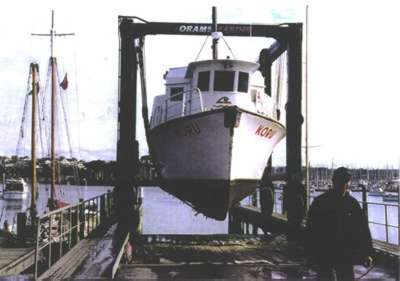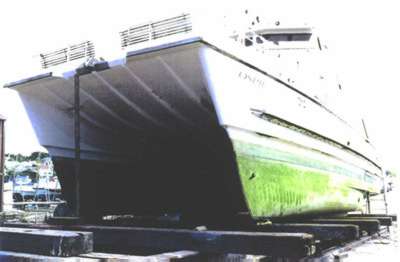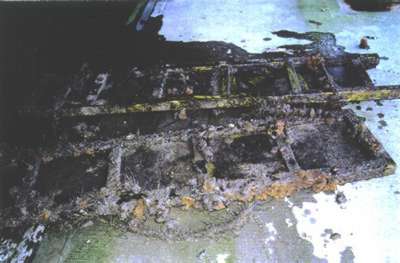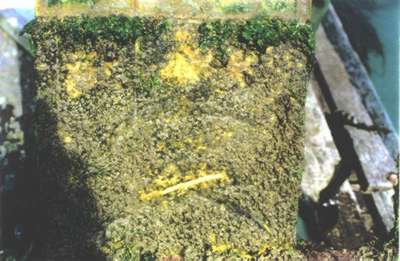ABSTRACT
Cu-Nis are alloys, which possess a combination of excellent corrosion resistance and a high natural resistance to biofouling in seawater. They have a proven performance record over many years in applications such as seawater piping, intake screens, water boxes, and for cladding of offshore structures. The property combination also makes Cu-Ni an attractive material for boat hulls, either as the hull material itself or applied as sheathing. A recent development has been the application of 90-10 Cu-Ni sheathing as an adhesive-backed thin foil to ship hulls.
This paper describes trials and evaluation of 90-10 Cu-Ni sheathing on the hulls of two commercial passenger ferries, in service on the Auckland Harbour, New Zealand. One vessel is a slow ferry (10 knots), constructed of fibreglass-reinforced polymer, which was retrofitted with Cu-Ni sheathing in 1993. The other vessel is a fast catamaran ferry (22 knots) with an FRP hull, which was sheathed with Cu-Ni foil during construction in 1994, and has been in commercial service for about 30 000 nautical miles since construction.
The five-year project has shown that Cu-Ni sheathing of ship hulls provides an effective antifouling regime on the commercial vessels used in the trials. Corrosion control measures on the sheathed hulls need special attention, but the control procedures are in line with marine corrosion mitigation practices. Erosion- corrosion of the Cu-Ni foil on ship rudders is one area that needs to be monitored regularly.
Back to TopINTRODUCTION
Biofouling is commonplace on immersed marine structures, including the hulls of vessels such as harbour ferries, which are in routine commercial service. Regular removal of macrofouling is an operational requirement on passenger ferries, otherwise the vessels suffer hydrodynamic drag problems during service and fuel consumption rises proportionately. The cost associated with removal of macrofouling from a ship's hull can be high, particularly when a fleet of commercial ferries requires regular dry-docking for maintenance.
The principal commercially available Cu-Ni alloys, 90-10 (UNS C70600) and 70-30 (UNS C71500), are solid solution alloys, which exhibit excellent fabrication characteristics, useful mechanical properties and a high level of corrosion resistance in seawater (1). Forming and welding of these alloys is relatively uncomplicated and they have enjoyed many successful applications in the marine industry (2,3).
90-10 Cu-Ni is recognised for its excellent resistance to corrosion and additionally is known to have a high inherent resistance to biofouling. It was first used as a boat hull material in 1971 and a survey in 1994 of the behaviour of the vessels built, since that time, showed good performance. The corrosion rates of 90-10 Cu-Ni alloy in seawater (1) have also been studied. The 90-10 alloy has an acceptably low corrosion rate in seawater, except when the water is heavily polluted. As such, coatings and cathodic protection are unnecessary.
Long term research at the LaQue Center for Corrosion Technology, USA, and service experience on the legs of Stage 1 of the Morecambe Field gas platforms, UK, have shown that 90-10 Cu-Ni alloy has good characteristics for the sheathing of marine steel structures in the splash, spray and tidal zones, where corrosion can otherwise be very severe (4,5). The accumulation of biofouling on insulated 90-10 sheathing was also shown (5) to be less than 2% of that occurring on corresponding areas of bare steel. Thus, 90-10 Cu-Ni alloy has a proven record for use as a sheathing material on marine structures, whether they be static, such as offshore platform piles, or dynamic, as on seagoing ships (4).
Observations of the biofouling resistance of the 90-10 Cu-Ni alloy under normal exposure conditions on vessels and offshore platforms suggest that microfouling does not build up sufficiently to allow macrofouling to become established. Under quiescent or stagnant conditions macrofouling can eventually occur, but larger marine growths will periodically slough off during service as seawater flow conditions are established. In addition, biofouling, which does accumulate on a hull, can be easily removed by wiping, or with a gentle scraping action.
For optimum fouling resistance, 90-10 Cu-Ni must be freely exposed and not subject to galvanic contact with less noble metals, such as zinc anodes, or skin fittings. Cathodic protection (CP) can significantly reduce the biofouling resistance of the 90-10 Cu-Ni and the alloy must be electrically isolated from any on-hull CP system (2).
About ten years ago, Mitchell developed a proprietary adhesive-backed copper nickel foil in the United Kingdom for application to wood, glass-fibre and steel boats. This was applied to about forty boats over the years and, when correctly applied, the performance was very encouraging. In 1992, work began to develop the process further in New Zealand. Cu-Ni foil has now been applied to medium size pleasure craft and two commercial fleet ferries, by Copper Mariner Ltd, enabling the observation of more exacting service conditions and allowing a more detailed evaluation to be documented, than had previously occurred.
In parallel trials, test panels prepared using the Cu-Ni cladding have been immersed in seawater at Singapore Harbour (1 year), Langstone Harbour, UK, (3 years), and in the Auckland Harbour (5 years). The seawater trials in Langstone and Auckland Harbours are to assess the 90-10 Cu-Ni cladding performance on materials such as steel and aluminium alloys, as well as on FRP and painted wood.
Back to TopEVALUATION OF 90-10 Cu-Ni SHEATHING
2.1 The Sheathing System and Evaluation Programme
The sheathing of a ship's hull with Cu-Ni foil involves the application of adhesive-backed panels (approximately 210mm x 500mm) to the prepared hull, allowing about 15mm overlap. The Cu-Ni foil thickness chosen is about 0.15mm thick. The panels are easily cut and manipulated even over the most difficult contours.
The bonding system acts as an insulator and as a barrier to seawater, which protects the hull from the corrosive actions of seawater on its own. An advantage of the system has been that if impact occurs and some panels are damaged, it takes only a short time to repair the sheathing. The system can be applied to hulls on new vessels and as a retrofit.
An evaluation programme on the installation and performance of the foil sheathing commenced in August 1993. This paper concentrates on the MV Koru and the MV Osprey; both of which are in-service on Auckland Harbour. In addition, test programmes involving trials on immersed test panels, commenced over the same time (1993-1999). One of the test panel trials, at Langstone Harbour, UK, is continuing.
Back to Top2.2 MV Koru
An old 48 tonne ferry, the MV Koru (Figure 1), had the FRP hull sheathed with Cu-Ni foil in 1993. Koru is a slow ferry, which travels at about 10 knots, and is held mostly in reserve for emergencies. The fouling and corrosion performance of the sheathed hull were monitored by inspection at dry-docking intervals, over the following years.
Several teething problems linked with understanding the galvanic action situation presented by the new hull protection system, whilst retaining some existing hull fittings, were addressed and overcome. The nature of these problems were as follows:
A 70-30 Cu-Ni shoe had been installed along the keel. Unexpectedly, this design promoted sufficient galvanic corrosion of the adjacent 90-10 panels to corrode their surfaces. The solution was to replace the keel shoe with FRP.
Fasteners holding the shoe were also corroding. These were made of silicon bronze, a less noble material than Cu-Ni. The silicon bronze was replaced with 316 stainless steel, which is more corrosion- resistant.
The rudder shoe and bearing attachments were made from manganese bronze and showed signs of dezincification, as did the propeller. Cathodic protection had been removed to achieve the optimum biofouling of the Cu-Ni and thus these components were no longer protected. Zinc anodes were then installed on the rudder shoe in such a way that they were electrically insulated from the hull.
Fouling, in terms of slime formation, had occurred which was generally slight to medium. This tended to be heavier on sides exposed to sunlight when moored. Some patches of small barnacles had formed, which seemed to have occurred preferentially on the adhesive at the overlap of the panels. Barnacles on the Cu-Ni were easily removed by finger pressure.
More recent inspections of the Koru's hull during dry-docking (1995-1999) have revealed that the early teething problems encountered with hull sheathing have been overcome.
 FIGURE 1. The ferry MV Koru, being hauled out of the harbour in Auckland. The vessel had last been hauled out one year previously. Note the relatively clean condition of the Cu-Ni sheathing after one year in seawater without cleaning.
FIGURE 1. The ferry MV Koru, being hauled out of the harbour in Auckland. The vessel had last been hauled out one year previously. Note the relatively clean condition of the Cu-Ni sheathing after one year in seawater without cleaning.MV Osprey
The 21-metre catamaran MV Osprey built as a fast passenger ferry, was launched in December 1994. The ferry has since been in passenger ferry service for about 30,000 nautical miles on the Waitemata Harbour in Auckland. Both FRP hull pontoons were sheathed from the waterline down with 90-10 Cu-Ni foil panels during construction (Figure 2).
During slipway inspections of the Osprey hull over the next two years, it was found that this vessel experienced the same galvanic corrosion problems with the keel strip encountered earlier with the Koru. Again, this required a replacement with FRP to solve the problem. The adhesive performed very well on the FRP hull. The other parts of the hull appeared in good condition, apart from the leading edges of the two rudder skegs which showed evidence of erosion-corrosion after six months'service. The erosion-corrosion problem on the foil at the stern can be tolerated and periodically the affected panels are replaced during a maintenance haulout.
Fouling again consisted of moderate algal growth. The growth was heavier on the exterior sides of the catamaran pontoons exposed to more sunlight. On the sheathed hull surfaces between the pontoons, where seawater velocity/turbulence are higher and sunlight exposure is less, the development of surface slime was minimal.
Another factor, which was found to be consistent on both the Koru and the Osprey, was that mechanical damage to the Cu-Ni panels (sustained through collisions with floating debris) was also minimal. The foil panels were not only durable, but they exhibited excellent mechanical properties, such as toughness and impact resistance. Additionally, any significant mechanical sheathing damage sustained on both vessels was quickly and easily repaired during normal maintenance time on the slipway.
 FIGURE 2. The catamaran ferry MV Osprey, being hauled out after one year's continuous service. Note that only slight microfouling (green algae) is visible where the hull is exposed to sunlight on the exterior surface of the nearest pontoon
FIGURE 2. The catamaran ferry MV Osprey, being hauled out after one year's continuous service. Note that only slight microfouling (green algae) is visible where the hull is exposed to sunlight on the exterior surface of the nearest pontoonAuckland Harbour Test Panel Trials
Between 1993 and 1999, two wooden frames each consisting of five 90-10 Cu-Ni sheathed panels, were immersed at the National Maritime Museum in the Waitemata Harbour, Auckland. The panels were painted aluminium and steel. The sheathed steel panels were supported by a painted wood frame, whereas the aluminium panels and wooden frame were totally clad with Cu-Ni foil (5).
The panels and frames were recovered, water-blasted and inspected in early 1999 (Figure 3). There was no evidence on any test panels of surface corrosion of the Cu-Ni foil or detachment of the adhesive from the substrates or the foil. There was no evidence observed of degradation of the adhesive material in seawater. When the bare adhesive is exposed to seawater for long periods, it becomes fouled with marine growth at about the same rate as a non-antifouling paint.
 FIGURE 3. Two test panel frames removed after five years' seawater immersion at the Maritime Museum site, Auckland harbour, NZ. The differing degrees of fouling on the wooden frames are visible. The nearer wooden frame (steel panels) is painted, whilst the farther frame (aluminium panels) is clad with 90-10 Cu-Ni foil.
FIGURE 3. Two test panel frames removed after five years' seawater immersion at the Maritime Museum site, Auckland harbour, NZ. The differing degrees of fouling on the wooden frames are visible. The nearer wooden frame (steel panels) is painted, whilst the farther frame (aluminium panels) is clad with 90-10 Cu-Ni foil.Singapore Harbour Test Panel Trials
In September 1994, a test panel assembly was submerged in the harbour at Singapore, in a 1-2 knot current. This location was chosen because experience was required with the adhesive-bonded 90-10 Cu-Ni foil panels in a warm, polluted seawater environment. The test panels were withdrawn and inspected monthly for a period of one year, from 1994 to 1995.
Generally, marine growth and fouling on the wooden support frames was very rapid, with heavy barnacle encrustation evident within three months' exposure. During the same time interval, there was some marine growth on the Cu-Ni panels, but it underwent little further change after the first three months.
Langstone Harbour Test Panel Trials
In August 1996, exposure panels were immersed from rafts in the tidal flow of Langstone Harbour in the UK. Triplicate panels of Cu-Ni sheathed steel, FRP and aluminium were exposed. Each panel was Cu-Ni sheathed, on both sides, for the lower two-thirds of the panel length. The upper third of each test panel was paint coated. The Cu-Ni sheathing on each test panel was exposed below seawater level. After 3.5 years' exposure, there were medium slime levels on the Cu-Ni and minimal levels of macrofouling.
Figure 4 shows a Cu-Ni sheathed FRP panel after 2.75 years' exposure in Langstone Harbour. This illustrates the low level of macrofouling on the Cu-Ni for this length of exposure time, and the ease with which the biofouling can be wiped off with finger pressure.
 FIGURE 4. A Cu-Ni sheathed FRP test panel after nearly 3 years' exposure in Langstone Harbour (United Kingdom). Finger pressure was sufficient to remove biofouling off the panel surface revealing the original 90-10 Cu-Ni substrate.
FIGURE 4. A Cu-Ni sheathed FRP test panel after nearly 3 years' exposure in Langstone Harbour (United Kingdom). Finger pressure was sufficient to remove biofouling off the panel surface revealing the original 90-10 Cu-Ni substrate.DISCUSSION
It is perhaps a natural progression of Cu-Ni alloy technology that development of an adhesive-backed sheathing system for the hulls of small and medium size pleasure and commercial craft should occur. A system that was originally developed in the United Kingdom has now been applied and given rigorous service experience in New Zealand
The overall assessment of the evaluations to date is that it has proved to be a viable system. The adhesive used under the foil has shown excellent adherence to the FRP boats examined. The biofouling resistance has been in line with documented accounts, such that microfouling does occur on the Cu-Ni but colonisation of macrofoulers is restricted. If colonisation does eventually occur, it can readily be removed by a wipe or finger pressure, so that a light waterblast will quickly remove any growth.
Corrosion of the Cu-Ni foil has only occurred on rudder skegs, a traditional problem area on any vessel. The erosion-corrosion damage is due to impingement by fast flowing seawater on the foil, which breaks down the passive oxide film. If seawater movement over the foil exceeds a certain breakdown velocity, 90-10 Cu-Ni alloy can suffer erosion-corrosion damage. Experience with boat hulls has shown that minimal corrosion occurs after about one year at 24 knots (12 m/s) and the highest recorded fluid velocity tolerated is 38 knots (19 m/s). This was on a patrol boat which showed no measurable loss of hull thickness after 200 hours at maximum operating speed.
The project has demonstrated that there are a number of factors that must be taken into account when considering the response of Cu-Ni to biofouling, namely:
- Seawater temperature;
- Access to sunlight;
- Velocity of the seawater;
- Avoidance of galvanic action.
3.1 Temperature
The effect of seawater temperature remains somewhat uncertain. However, a review of the test panel results obtained in quiet seawaters in Singapore and Auckland Harbours indicated that biofouling of the copper- nickel alloy foil in warm tropical seawater after one year exceeded the marine growth in temperate climate waters. Nevertheless, the ease of removal of biofouling was about the same in both tropical and temperate waters.
3.2 Sunlight
The experience on Koru and the Osprey showed that green algae (slime) formed predominantly on the Cu-Ni foil at, or just below the waterline on both vessels. In addition more algae was observed on one side of the Koru hull which was facing the sun during out-of-service time. Obviously, sunlight affects the rate of growth of the green fouling (photosynthesis), but the higher temperature of the surface seawater on sunny days may also be a factor. The green algae was easily removed using rotary brushing underwater, but the growth became firmly attached and more difficult to remove if it dried when the vessel was on the slipway.
3.3 Velocity
The velocity of the seawater had a substantial effect on the degree of fouling resistance of the Cu-Ni foil. Areas of the Koru and Osprey hulls were almost entirely free of biofouling where the velocity of seawater experienced by the alloy exceeded some undetermined speed. Turbulence was possibly a factor that also contributed to this observation. Typically, the stern and waterline were more likely to show signs of fouling initiation than other hull areas.
3.4 Galvanic Corrosion
It has been confirmed that the 90-10 Cu-Ni alloy must be freely exposed to seawater and it must not be subject to cathodic protection, or any other type of galvanic coupling, if it is to achieve maximum biofouling resistance. Any CP system must be electrically isolated from the Cu-Ni cladding on the ship's hull.
3.5 Presence of Pollutants on Corrosion of Cu-Ni
Finally, although some degree of pollution may be expected in harbours, no obvious effects on the copper- nickel foil were observed. Sulphide surface films from polluted waters can lead to pitting corrosion and to higher corrosion rates. Consequently, the use of Cu-Ni as a hull material is normally preferred for operation and moorings in cleaner waters. This is particularly important during the first weeks of exposure to seawater, while the protective surface oxide films are forming on the Cu-Ni. Once mature these films provide a better resistance to transient exposure to polluted seawaters. However, persistent exposure to such waters can have a deleterious effect on Cu-Ni.
CONCLUSIONS
A five-year evaluation of the feasibility of using 90-10 Cu-Ni adhesive-backed foil sheathing on the hulls of commercial passenger craft, to minimise biofouling, has shown that the system possesses certain special features:
- 4.1 The adhesive-backed Cu-Ni foil sheathing, trialled on two boat hulls and on test panels, is readily applied and has shown excellent adherence in the test programme. The system is suitable for new- build and retrofit.
- 4.2 For retrofits, care should be taken to establish the alloy identity of hull fittings. Steps may need to be taken to replace the fittings, or to ensure that their corrosion resistance is maintained and is compatible with the new Cu-Ni foil system on the hull. Any CP system installed must be located with care on the vessel's sheathed hull.
- 4.3 Cu-Ni has a good resistance to macrofouling, although microfoulants will form on the alloy.
- 4.4 Cu-Ni adhesive-backed foil has been found to effectively form part of an antifouling regime on the ferry hulls, to provide decreased fouling levels and reduced downtime on the slipway. Light waterblasting of the hull, once a year, removes any biofouling. Even this procedure becomes unnecessary with periodic underwater hull cleaning, while the vessel is out-of-service but in seawater.
Factors that may influence the resistance of Cu-Ni to biofouling are:
- The ambient seawater temperature;
- The degree of exposure to sunlight in seawater;
- The velocity of seawater along the ship's hull;
- Any galvanic coupling to less noble metals.
- 4.6 Regular inspection of the hull during dry-docking to check for mechanical damage, erosion-corrosion and galvanic corrosion, is an advisable precaution for maintenance of the system. The sheathing system is easily repaired if physical damage occurs during service. The sheathing shows good impact resistance and adds integral strength to the vessel's hull.
- 4.7 The test programme experience gained during the five year evaluation period of the system confirms similar performance results published in the USA and Europe during the past 27 years of trials and testing using 90-10 Cu-Ni alloy for the fabrication of ship hulls in marine service.
ACKNOWLEDGEMENT
The authors thank Fullers Group Limited (Auckland) for permission to publish this work. In particular, thanks are expressed to Messrs George Hudson and Michael Fitchett of Fullers.
References
- Controlling Biofouling on Ferry Hulls with Copper Nickel, Boulton, L. H., C. A. Powell, and W. B. Hudson, Additional Papers, pp 73-87, , 10th International Congress on Marine Corrosion and Fouling, University of Melbourne, DSTO General Document DSTO-GD-0287. Defence Science & Technology Organisation, Australia .
- Corrosion and Biofouling Protection of Ship Hulls Using Copper-Nickel, Powell, C. A, , International Conference on Marine Corrosion Prevention: A Re-Appraisal for the Next Decade, London, .
- Cu-Ni Sheathing and its Use for Ship Hulls and Offshore Structures, Powell, C. A., Int. Biodeterioration & Biodegradation, pp 321-331, , .
- Fabrication of Copper-Nickel Alloys for Offshore Applications, Jordan, D. E. and Powell, C. A., , International Conference on Welding in Maritime Engineering, Croatian, Croatian Welding Society, .
- Thirteen Year Results of Long-Term Copper-Nickel Sheathed Piling Studies, Pikul, S. J. and B. S. Phull, , Annual Report, ICA Project No. 358 .
